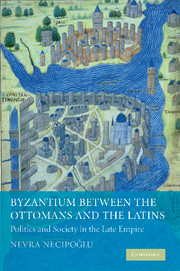Book contents
- Frontmatter
- Contents
- List of maps
- Acknowledgements
- Note on transliteration
- List of abbreviations
- Map 1 The Byzantine world in the fourteenth–fifteenth centuries
- Map 2 Byzantium and its neighbors, c. 1350
- Map 3 Byzantium and its neighbors after 1402
- PART I INTRODUCTION AND POLITICAL SETTING
- PART II THESSALONIKE
- 3 Social organization, historical developments, and political attitudes in Thessalonike: an overview (1382–1430)
- 4 Byzantine Thessalonike (1382–1387 and 1403–1423)
- 5 Thessalonike under foreign rule
- PART III CONSTANTINOPLE
- PART IV THE DESPOTATE OF THE MOREA
- Conclusion
- Appendix I Archontes of Thessalonike (fourteenth—fifteenth centuries)
- Appendix II “Nobles” and “small nobles” of Thessalonike (1425)
- Appendix III Constantinopolitan merchants in Badoer's account book (1436–1440)
- Appendix IV Members of the Senate of Constantinople cited in the synodal tome of August 1409
- Appendix V Some Greek refugees in Italian territories after 1453
- Bibliography
- Index
5 - Thessalonike under foreign rule
Published online by Cambridge University Press: 07 December 2009
- Frontmatter
- Contents
- List of maps
- Acknowledgements
- Note on transliteration
- List of abbreviations
- Map 1 The Byzantine world in the fourteenth–fifteenth centuries
- Map 2 Byzantium and its neighbors, c. 1350
- Map 3 Byzantium and its neighbors after 1402
- PART I INTRODUCTION AND POLITICAL SETTING
- PART II THESSALONIKE
- 3 Social organization, historical developments, and political attitudes in Thessalonike: an overview (1382–1430)
- 4 Byzantine Thessalonike (1382–1387 and 1403–1423)
- 5 Thessalonike under foreign rule
- PART III CONSTANTINOPLE
- PART IV THE DESPOTATE OF THE MOREA
- Conclusion
- Appendix I Archontes of Thessalonike (fourteenth—fifteenth centuries)
- Appendix II “Nobles” and “small nobles” of Thessalonike (1425)
- Appendix III Constantinopolitan merchants in Badoer's account book (1436–1440)
- Appendix IV Members of the Senate of Constantinople cited in the synodal tome of August 1409
- Appendix V Some Greek refugees in Italian territories after 1453
- Bibliography
- Index
Summary
THE FIRST OTTOMAN DOMINATION (1387–1403)
Following the surrender of Thessalonike in April 1387, the Ottoman forces that entered the city no doubt caused a certain amount of commotion and disarray, arousing alarm and apprehension among some of the citizens at least. Yet, as the immediate turmoil and upheaval subsided, things seem to have returned to a normal state. According to an enkomion of the city's future archbishop Gabriel (1397–1416/17) which some scholars attribute to Makarios Makres, the Ottomans treated the inhabitants of Thessalonike in an unexpectedly kind and gentle manner during the early 1390s. While Gabriel's encomiast formulaically ascribes this to the continued protection of the city by Saint Demetrios rather than to the policy and actions of the Ottomans themselves, he indicates nonetheless that the Ottoman domination was not as severe as some Thessalonians had expected. It is also clear from Isidore Glabas' two homilies of 1393 (discussed above, chapter 4) that Ottoman rule did not lead to profound changes in the administrative and social structure of Thessalonike. The city maintained a semi-autonomous status, and the task of administration remained in the hands of the local Greek magistrates. Consequently, some of the social tensions and civil discords from the Byzantine period, in particular the conflicts between the common people and the archontes, were perpetuated through the years of the first Ottoman domination.
- Type
- Chapter
- Information
- Byzantium between the Ottomans and the LatinsPolitics and Society in the Late Empire, pp. 84 - 116Publisher: Cambridge University PressPrint publication year: 2009



